
Bumblebee
| Product Overview |
A bumblebee used to pollinate crops, which does not easily occur naturally. |
| Included |
1. Beehive (1 colony) - 1 queen bee, 60~80 worker bees, and many eggs and larvae |
| Recommended quantity |
· Recommended quantity |
 What Is a kochbuni Bumblebee?
What Is a kochbuni Bumblebee?
The kochbuni bumblebee belongs to the family of the European bumblebee (bombus terrestris), which is most suitable for pollination among many bees in the natural ecosystem. It has been developed for the first time with the own Korean technology through technical support from the Agricultural Science and Technology Research Center of Kyungpook National University and the production cooperation system of Industrial Insect Research Institute of Yecheon-gun. A commercial name for the so-called bumblebee (Trademark Application 2004 - 1842)
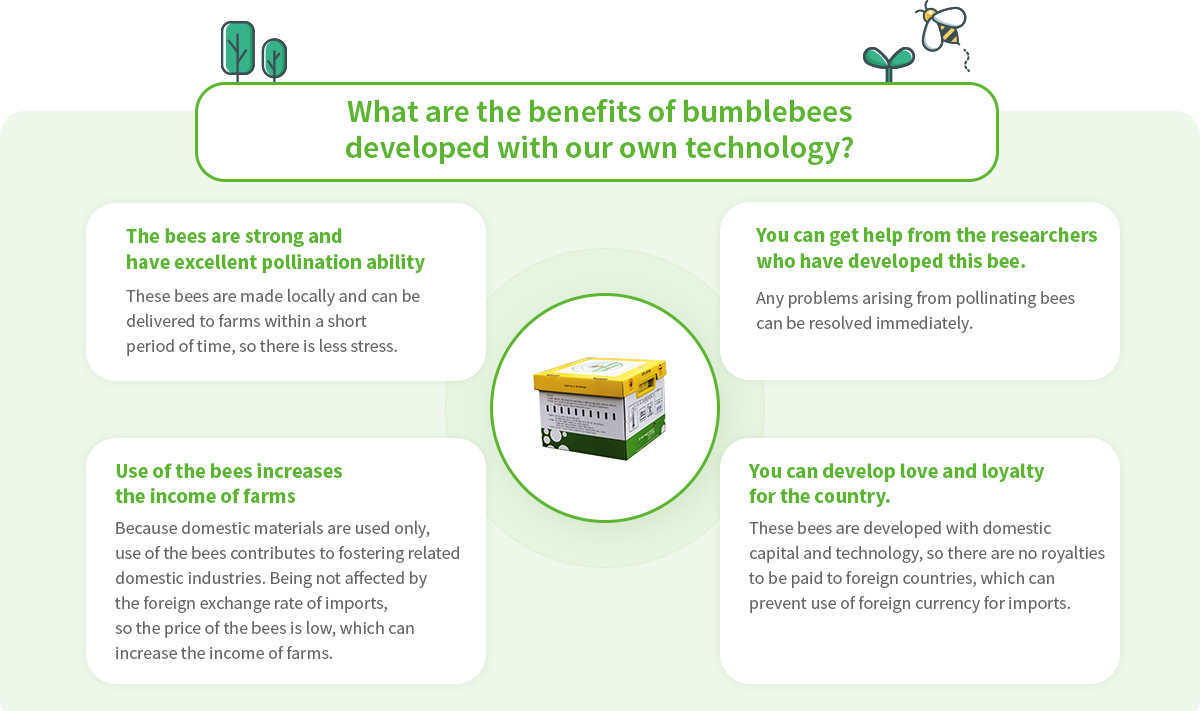
 Included in the Product
Included in the Product
· Beehive (1 colony) - 1 queen bee, 60~80 worker bees, and many eggs and larvae
· 1 bag of pollen
(※ Be sure to keep the pollen in the freezer.)
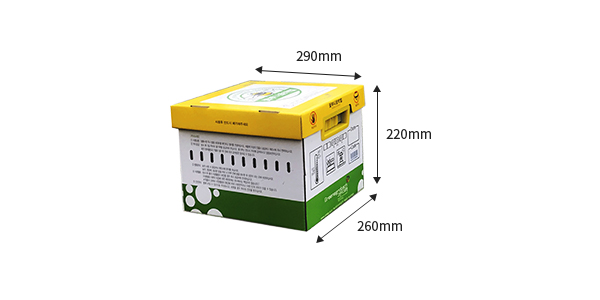
 Features and Strengths
Features and Strengths
Characteristics of pollination bumble bee
| Features | Details |
|---|---|
| Strong homing instinct | Colony led by a queen and hierarchical social life like honeybees |
| Unique flower visiting behavior | Pollination with its buzz foraging behavior by pectoral vibration |
| Long tongue | Capable of visiting flowers with long peduncles that honeybees avoid |
| Environmental adaptability | Visiting flowers even in low temperatures (5~6°C), cloudy or rainy days, or light snow |
Advantages of pollination bumble bee
| Strengths | Details |
|---|---|
| Labor saving | Replacing pollination by chemicals (1 colony capable of performing pollination for 200 ~ 300 pyeong) |
| Increased yields | Deformities decreased and productivity increased |
| Quality competitiveness | Increase in fruit weight, size, number of seeds, and sugar content, acidity |
| Identification of cross-pollination | Capable of visiting flowers with long peduncles that honeybees avoid and leaving traces of teeth on flowers |
| Adaptability to harsh environment | Capable of coexisting with crops and useful insects, and avoiding toxic pesticides |
| Eco-friendly agriculture | Contribution to production of high-quality, low-pollution fruits and vegetables, and branding of local products |
 Target Crops
Target Crops
Crops pollinated by pollination bumble bee
| Class. | Target Crops | Application Sites |
|---|---|---|
| Fruits and vegetables grown in a facility | Tomato, strawberry, eggplant, red pepper, green pepper, Oriental melon, melon, watermelon, pumpkin, kiwi, etc. | Greenhouse |
| Fruit trees growing in the field | Apple, pear, peach, plum, sweet persimmon, mango, almond, cherry, etc. | Orchard and facility |
| Seed production | Red pepper seeds, cabbage seeds, radish seeds, red radish seeds, onion seeds, etc. | Field and facility |
The pollination period is about 45 to 60 days (the pollination period may vary significantly depending on the temperature, humidity, and crops).
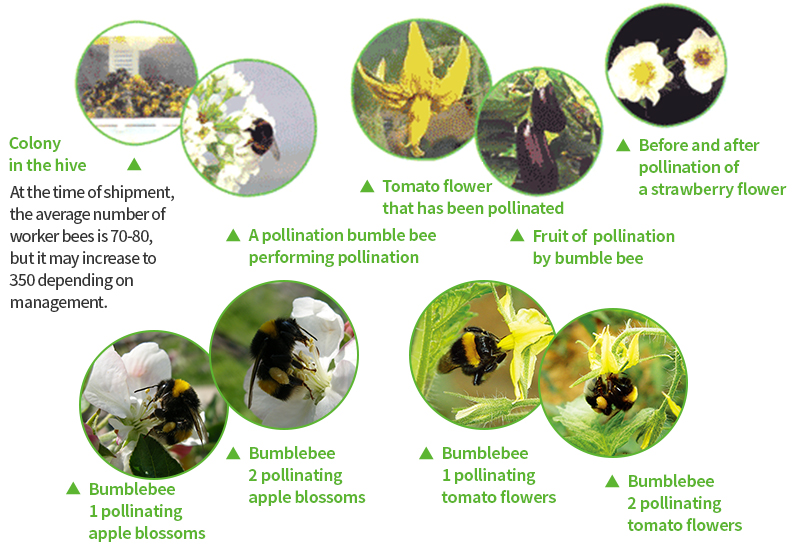
 How to Use
How to Use
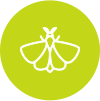
Prior to release
Before release, check the field condition and apply pesticides and fungicides (contact us) to control the density of pests and suppress diseases. In addition, if the inside of the facility is humid, proper ventilation should be provided in order to support the flower visiting activities of the bumblebees.

How to prepare for pollination
1. Preparation of the materials
· Plastic container boxes (2 boxes per beehive)
· Two pieces of styrofoam (1 bigger than the container box, 1 the same size as the box)
· Insulating materials (non-woven fabric, etc.) in winter
2. Position of the beehive (please keep the hive level)
· Position the hive so that the entrance faces the morning light, but avoid direct sunlight.
3. Installation of the beehive
· Summer: Dig the ground and install the beehive so that the entrance is at the same height as the ground for insulation. However, when installing it on the ground, use the materials prepared as shown in Figure 1.
· Winter: Insulate the hive with the insulating material as shown in Figure 2. (*When installing using methods other than the above, consider vibration, rainwater, and direct sunlight. If there are many ants in the field, install sticky traps around the hive.)


4. Releasing the bees for pollination
· In order to reduce the stress of migration, allow the bees to rest for at least 2-3 hours after the hive is installed.with the ceiling, side windows, and doors closed, open the entrance of the hive to release the bees.
(It does not matter if there is a insect net)
(Please be careful not to allow a bee to escape while making its first flight – if there is a bee escaping during a test flight for checking the food and environmental conditions inside the greenhouse, the activity of the bees may decrease and the escape rate may increase.)
 Precautions for Handling
Precautions for Handling
· Please check the residual period of pesticides before purchasing bees!
(Some pesticides have a long residual period or are toxic to bumblebees (pollinating bees), so you may not be able to install the hive. Please contact us for more information.).
· before spraying pesticides, closed the entrance the night before, take out the beehive outside, and spray it the next day.
(Most fungicides have a residual period of 1 to 2 days, and pesticides 3 to 7 days but there may be variations in the residual period depending on the pesticides, please contact us).
· Install screens on side windows and entrance before installing the hive.
(This can reduce the escape rate of bees and prevent damage by pesticides from the surrounding environment.)
· Keep the pollen in the freezer. Feed the bees after checking their flower-visiting activity. Feed the bees in the evening half a teaspoon to one teaspoon every 2 or 3 days
When flower-visiting activity decreases, stop feeding, and feed again when the activity increases.
· You may get stung by a bee if you are near the hive or touch the hive during release. Therefore, if possible, avoid touching the hive during the day. If you are stung by a bee, apply ammonia water or take an antihistamine, and if the symptoms are severe, follow your doctor's instructions.
 Product Installation Diagram
Product Installation Diagram
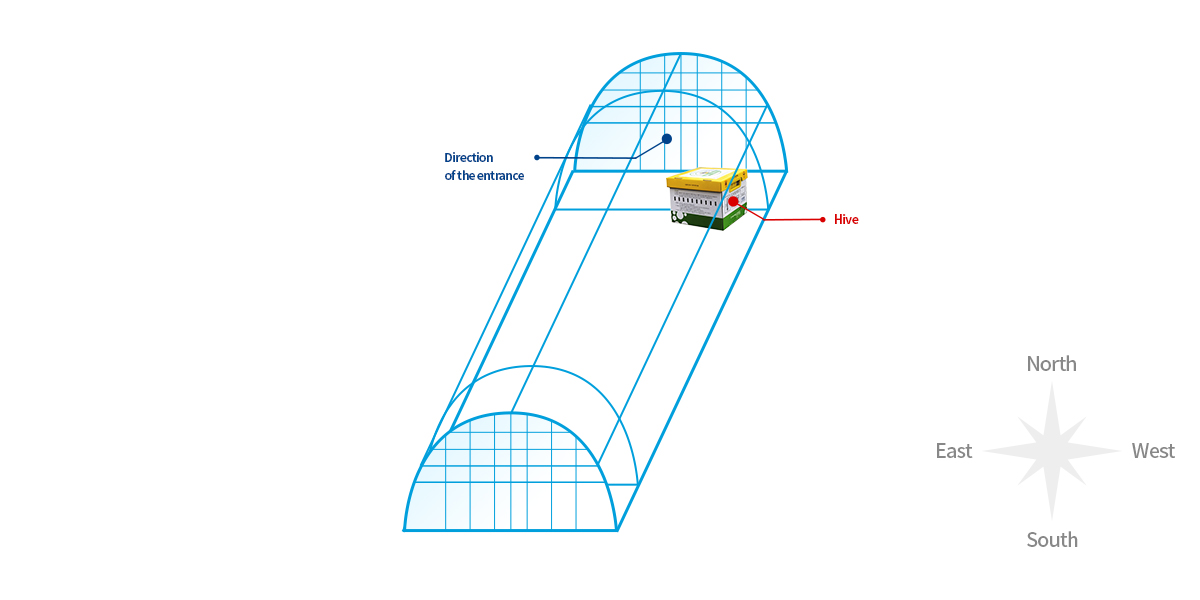
- Install the entrance in the direction of sunrise (southeast)
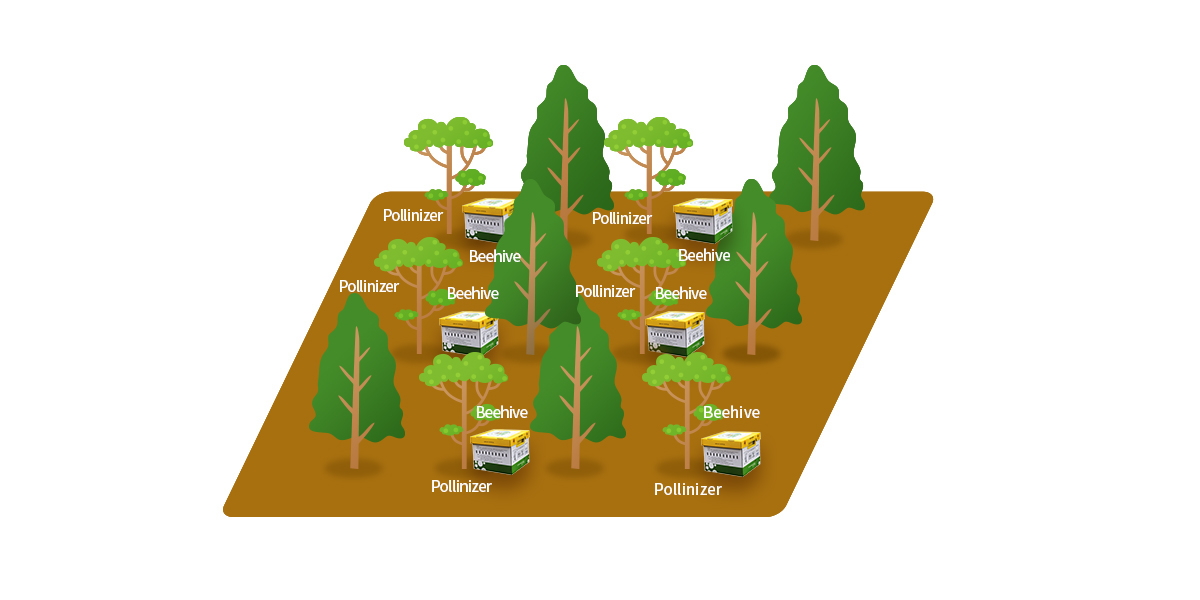
- Install a beehive within a 5-m radius of a pollinizer
- Install at least 6 hives, supposing that there are pollinating insects such as bees and butterflies.
 FAQ
FAQ
Is this a bumblebee?
This bee is bombus terrestris
The bumblebee belongs to the bombus genus, and this bee is a European bumblebee.
How many worker bees are in the hive?
Each hive has an average of 70-80 worker bees, with many eggs and larvae as well. With good maintenance, the number of worker bees can reach 350.
Can I continue to use the hive?
This bee is different from honey bees, which are used for beekeeping, and can be considered a perennial bee. The queen bee mostly lives about 3 months, but considering the breeding period in the breeding room, the average period used by farmers is 45 to up to 60 days.
Is it acceptable for bees to bite larvae?
Yes, it is acceptable. Of course, it is not good to bite a lot of larvae. However, if there is no food, the bee will kill larvae first.
Here are some solutions for bees killing their larvae:
1. Lack of food
=> Feed one teaspoon of pollen to the hive once every two days
2. Excessive humidity due to poor ventilation
=> Ventilate the greenhouse
3. Average temperature below 12℃ in the facility
=> Cover the hive with insulation materials and increase the temperature inside the facility.
Is it acceptable for ants or common insects to enter the hive?
No, it is not good if ants or other insects enter the hive. In particular, ants and Eulophidae (natural enemies) can shorten the lifespan of bumblebees, so it is recommended to install sticky traps around the hive to get rid of them.
There are a lot of bees in the hive, but they don't come out?
Frequently, bees do not come out of the hive because of poor conditions in the facility. Here, poor conditions include not only high temperature and excessive humidity, but also lack of pollen.
It's been a month since the release of the bees, and some of the bees keep sitting on the ceiling and frame of the greenhouse or leaves of crops, is this OK?
Those bees are male bees, not worker bees. So you don't need to worry about them.
When is the best time to replace the hive?
It is very difficult to know exactly when the hive should be replaced. In general, when you sit in front of the hive for 29 minutes between 8:00 a.m. and 10:00 a.m. on a sunny day (8:00–10:30 in summer, 9:00–10:30 in winter) and count the number of times the bees enter or leave the hive, and if the number is 20 to 15 or more, there is no problem. If the number is 15 to 10 times, it is normal, but if it is less than 10 times, you may decide to replace the hive after consulting. In addition, pollination of more than 70% of blooms per week would be good sign, 70-60% would be normal, but if it is less than 50%, you can also consider replacing the hive. However, this may vary depending on the Farm environment.
When should I give the pollen to the bees?
You can give the pollen once every 2-3 days. The amount of pollen should not exceed one or two teaspoons. If bees occasionally take out larvae from the hive, give the pollen once every 1-2 days for a week, and then 1-2 times every 2-3 days again.
I got stung by a bee. What should I do?
If you get stung by a bee and have itching, difficulty breathing, or a rash, you should go to the hospital immediately and take an antihistamine (shot or medicine). It is recommended to avoid touching the hive, especially if you have been drinking alcohol or using cosmetics containing a lot of alcohol.





